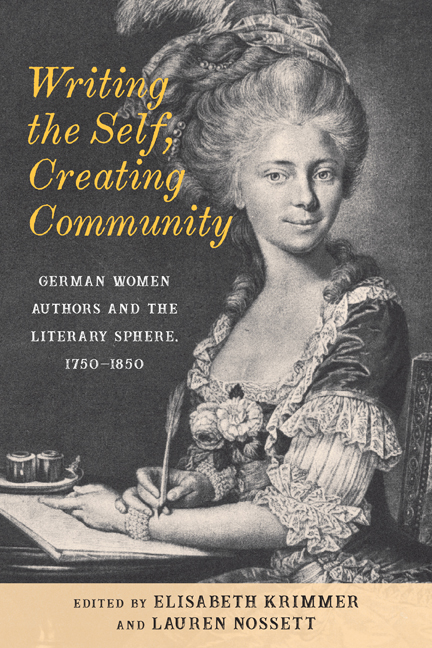Book contents
- Frontmatter
- Contents
- Acknowledgments
- Introduction
- Part I Writing a Community
- 1 Empowering Germany’s Daughters: On the Pedagogical Program and the Poetic Techniques of Sophie von La Roche
- 2 “Ich spreche lieber von guten Büchern”: Sophie von La Roche’s Concept of Female Authorship and Readership
- 3 Challenging Female Ideals: Marie-Elisabeth de La Fite’s Translation of Sophie von La Roche’s Geschichte des Fräuleins von Sternheim
- 4 Catherine II, Polyxene Büsching, and Johanna Charlotte Unzer: A Literary “Community of Practice”
- Part II Writing the Self
- 5 Ghostwriters: The Apparitional Author in Benedikte Naubert’s “Die Weiße Frau” (1792) and Sophie Albrecht’s Das Höfliche Gespenst (1797)
- 6 Vampirism Inverted: Pathology, Gender, and Authorship in Karoline von Günderrode’s “Die Bande der Liebe”
- 7 Wozu eine Amazonen—Literatur? Literary Creativity and Productivity in the Writings of Helmina von Chézy
- 8 Women Writers and the Märchenoma: Foremother, Identity, and Legacy
- Part III Writing toward Emancipation
- 9 The Illegitimacy of Authorship and the Legitimization of Passion in Agnes von Lilien
- 10 The Politics of the Female Body in Louise Aston’s and Fanny Lewald’s Writings through the Prism of the Romantic Theory of Sociability and Dialogue
- 11 Weibliche Irrsterne: Louise Otto and the Notion of Female Genius in Nineteenth-Century Germany
- Bibliography
- Notes on the Contributors
- Index
3 - Challenging Female Ideals: Marie-Elisabeth de La Fite’s Translation of Sophie von La Roche’s Geschichte des Fräuleins von Sternheim
Published online by Cambridge University Press: 01 October 2020
- Frontmatter
- Contents
- Acknowledgments
- Introduction
- Part I Writing a Community
- 1 Empowering Germany’s Daughters: On the Pedagogical Program and the Poetic Techniques of Sophie von La Roche
- 2 “Ich spreche lieber von guten Büchern”: Sophie von La Roche’s Concept of Female Authorship and Readership
- 3 Challenging Female Ideals: Marie-Elisabeth de La Fite’s Translation of Sophie von La Roche’s Geschichte des Fräuleins von Sternheim
- 4 Catherine II, Polyxene Büsching, and Johanna Charlotte Unzer: A Literary “Community of Practice”
- Part II Writing the Self
- 5 Ghostwriters: The Apparitional Author in Benedikte Naubert’s “Die Weiße Frau” (1792) and Sophie Albrecht’s Das Höfliche Gespenst (1797)
- 6 Vampirism Inverted: Pathology, Gender, and Authorship in Karoline von Günderrode’s “Die Bande der Liebe”
- 7 Wozu eine Amazonen—Literatur? Literary Creativity and Productivity in the Writings of Helmina von Chézy
- 8 Women Writers and the Märchenoma: Foremother, Identity, and Legacy
- Part III Writing toward Emancipation
- 9 The Illegitimacy of Authorship and the Legitimization of Passion in Agnes von Lilien
- 10 The Politics of the Female Body in Louise Aston’s and Fanny Lewald’s Writings through the Prism of the Romantic Theory of Sociability and Dialogue
- 11 Weibliche Irrsterne: Louise Otto and the Notion of Female Genius in Nineteenth-Century Germany
- Bibliography
- Notes on the Contributors
- Index
Summary
A CAREFUL STUDY of the diverse, multifaceted translation practices of female literary mediators at the end of the eighteenth century can magnify pivotal and controversial social issues, including traditional gender roles, the education of women, and the institution of marriage. These and other questions were negotiated by literary women, preferably in the unsuspicious, seemingly docile medium of translation. The mask of the literary mediator provided room to maneuver, and some female translators excelled at taking advantage of that. Translation as a form of speaking indirectly allowed them to articulate their own positions through individually motivated translation strategies either with or against the main thrust of the respective source text. In each of these translations various combinations of conservative and emancipatory elements can be observed, mirroring social controversies.
Since the 1990s, numerous studies—some of them in the direct tradition of Lori Chamberlain's “Gender and the Metaphorics of Translation” (1988)—have analyzed various women translators who used literary or scientific translations as a means of participating secretly in public debates, articulating personal matters, or even promoting protofeminist ideas. Hilary Brown (with reference to Carol Maier) has rightly pointed to the need for a “heightened sensitivity to the complexities of gender as an analytical category.” Brown also warns of giving “hagiographic and lopsided” versions of the past by sticking uncritically to the preconceived idea of the marginalized woman and her seemingly innocent but actually subversive translational activity.
As I pointed out elsewhere and as I will show in this article, the activities of women translators in the eighteenth century do not necessarily contribute to a story of emancipation. Depending on their individual character, attitudes, and motives, their education, social status, and other factors, women use heterogeneous translational strategies, either reproducing conservative self-images or subverting traditional gender roles, in many cases ambiguously oscillating between these two poles. These ambiguous tendencies can be seen as a response to the socially anchored need to justify any kind of female literary activity. While some women translators felt confident enough to resist these expectations and to articulate their own (progressive) ideas in a translated text, others deliberately chose to hide “behind inverted commas.”
- Type
- Chapter
- Information
- Writing the Self, Creating CommunityGerman Women Authors and the Literary Sphere, 1750–1850, pp. 68 - 85Publisher: Boydell & BrewerPrint publication year: 2020



